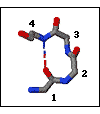I am in a 300-level molecular biology class and am unclear about this concept and how to delineate motifs versus domains of proteins. Any suggestions would be much obliged.
4 Answers
These are completely different concepts, which sometimes may be connected.
A motif in biology is a mathematical model, typically of a sequence, that predicts which sequences belong to some defined group. For example, a DNA sequence motif can characterize the binding site of a transcription factor, i.e. which sequences tend to be bound by this factor. For proteins, sequence motifs can characterize which proteins (protein sequences) belong to a given protein family. A simple motif could be, for example, some pattern which is strictly shared by all members of the group, e.g. WTRXEKXXY (where X stands for any amino acid). There are also more complex motif models.
Protein domains, on the other hand, are a structural entity, usually meaning a part of the protein structure which folds and functions independently. So, proteins are often constructed from different combinations of these domains.
So how are motifs and domains related? Well, when you think about protein families, it makes sense not only to look at the whole sequence but also to focus on individual domains. Since they are a elementary functional-structural units, it makes sense to find sequence motifs for individual domains. So, you often find that a protein contains multiple domains, each domain characterized by having a sequence that matches the motif of its family.
-
1$\begingroup$ adding to the answer of @Bitwise: Motif is just a statistically well represented pattern in a data. It can be a sequence or even a structure. Motifs CAN be sometimes associated with particular functions $\endgroup$– WYSIWYGCommented Apr 8, 2013 at 12:56
-
$\begingroup$ @WYSIWYG thanks for the clarification, I was going to mention structural motifs but forgot to write it. $\endgroup$– BitwiseCommented Apr 8, 2013 at 18:08
-
$\begingroup$ This was very helpful, thanks for the reply. :) $\endgroup$– LaurenCommented Apr 9, 2013 at 19:31
The principal difference is that domains are independently stable, while motifs are not.
Here is a bit on motifs: http://www.sinauer.com/pdf/nsp-protein-1-16.pdf
A motif can be part of a domain. From there:
The second, equally common, use of the term motif refers to a set of contiguous secondary structure elements that either have a particular functional significance or define a portion of an independently folded domain.
Expanding on the comment made by @WYSIWYG, a motif is just a pattern. For proteins this pattern can either refer to a string of amino acids — a sequence motif — or the conformation and interaction of residues in space — a three-dimensional structural motif.
It is important to qualify the term ‘motif’ to indicate precisely what is meant.
Sequence motifs
A good illustration is the ATP-binding motif:
GXXGXFKS(or T)
This illustrates that not all positions need be specified (X) and that in some positions alternatives may occur (S or T).
Structural motifs
One type of structural motif involves small hydrogen-bonded structures such as beta-bulges, Schellman loops and beta-turns. A beta-turn is illustrated:
It can be simply defined as “A motif of four consecutive residues and one H-bond in which a H-bond occurs between main-chain CO of residue-1 and main-chain NH of residue-4”. Alternatively, subcategories can be defined in terms of the dihedral angles at residues 2 and 3.
After the peptide chain of a protein has been organised into successive stretches of secondary elements, combinations of such elements are first arranged into distinctive groups called super secondary motifs. Several neighbouring secondary elements and supersecondary motifs are folded and twisted further into compact globular cluster called a domain.
-
$\begingroup$ Do you have a reference to this? $\endgroup$– user3795Commented Jul 24, 2013 at 8:59

